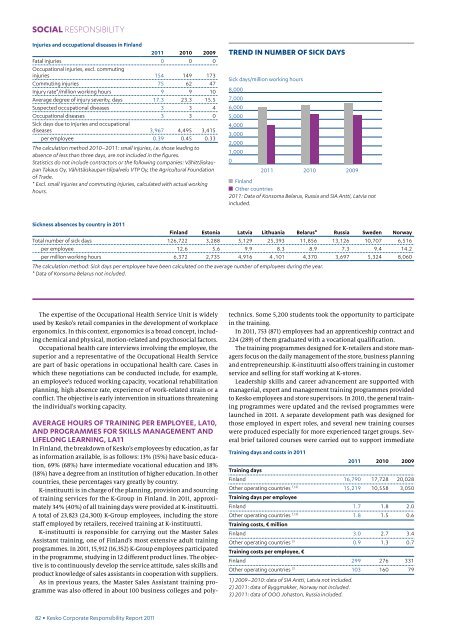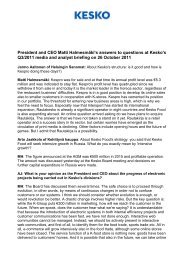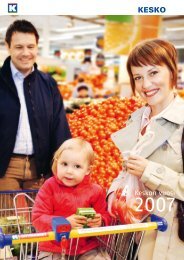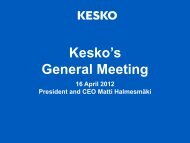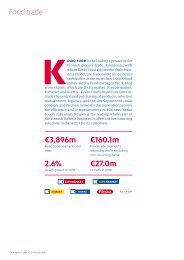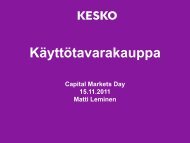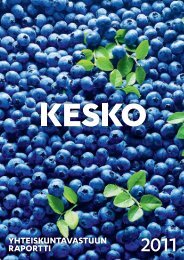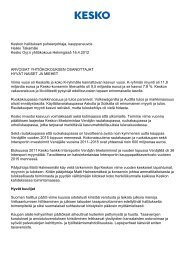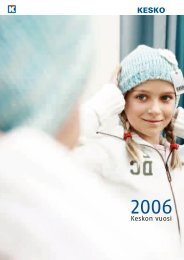Pdf version (3.2 MB) - Kesko
Pdf version (3.2 MB) - Kesko
Pdf version (3.2 MB) - Kesko
Create successful ePaper yourself
Turn your PDF publications into a flip-book with our unique Google optimized e-Paper software.
sOCIal REsPONsIBILITy<br />
Injuries and occupational diseases in Finland<br />
2011 2010 2009<br />
Fatal injuries<br />
Occupational injuries, excl. commuting<br />
0 0 0<br />
injuries 154 149 173<br />
Commuting injuries 75 62 47<br />
Injury rate*/million working hours 9 9 10<br />
Average degree of injury severity, days 17.3 23.3 15.5<br />
Suspected occupational diseases 3 3 4<br />
Occupational diseases<br />
Sick days due to injuries and occupational<br />
3 3 0<br />
diseases 3,967 4,495 3,415<br />
per employee 0.39 0.45 0.33<br />
The calculation method 2010–2011: small injuries, i.e. those leading to<br />
absence of less than three days, are not included in the figures.<br />
Statistics do not include contractors or the following companies: Vähittäiskaupan<br />
Takaus Oy, Vähittäiskaupan tilipalvelu VTP Oy, the Agricultural Foundation<br />
of Trade.<br />
* Excl. small injuries and commuting injuries, calculated with actual working<br />
hours.<br />
Sickness absences by country in 2011<br />
Finland Estonia Latvia Lithuania Belarus* Russia Sweden Norway<br />
Total number of sick days 126,722 3,288 5,129 25,393 11,856 13,126 10,707 6,516<br />
per employee 12.6 5.6 9.9 8.3 8.9 7.3 9.4 14.2<br />
per million working hours 6,372 2,735 4,916 4 ,101 4,370 3,697 5,324 8,060<br />
The calculation method: Sick days per employee have been calculated on the average number of employees during the year.<br />
* Data of Konsoma Belarus not included.<br />
The expertise of the Occupational Health Service Unit is widely<br />
used by <strong>Kesko</strong>’s retail companies in the development of workplace<br />
ergonomics. In this context, ergonomics is a broad concept, including<br />
chemical and physical, motion-related and psychosocial factors.<br />
Occupational health care interviews involving the employee, the<br />
superior and a representative of the Occupational Health Service<br />
are part of basic operations in occupational health care. Cases in<br />
which these negotiations can be conducted include, for example,<br />
an employee’s reduced working capacity, vocational rehabilitation<br />
planning, high absence rate, experience of work-related strain or a<br />
conflict. The objective is early intervention in situations threatening<br />
the individual's working capacity.<br />
AvERAGE HOURS OF TRAINING PER EMPLOyEE, LA10,<br />
AND PROGRAMMES FOR SKILLS MANAGEMENT AND<br />
LIFELONG LEARNING, LA11<br />
In Finland, the breakdown of <strong>Kesko</strong>’s employees by education, as far<br />
as information available, is as follows: 13% (15%) have basic education,<br />
69% (68%) have intermediate vocational education and 18%<br />
(18%) have a degree from an institution of higher education. In other<br />
countries, these percentages vary greatly by country.<br />
K-instituutti is in charge of the planning, provision and sourcing<br />
of training services for the K-Group in Finland. In 2011, approximately<br />
34% (40%) of all training days were provided at K-instituutti.<br />
A total of 23,823 (24,300) K-Group employees, including the store<br />
staff employed by retailers, received training at K-instituutti.<br />
K-instituutti is responsible for carrying out the Master Sales<br />
Assistant training, one of Finland’s most extensive adult training<br />
programmes. In 2011, 15,912 (16,352) K-Group employees participated<br />
in the programme, studying in 12 different product lines. The objective<br />
is to continuously develop the service attitude, sales skills and<br />
product knowledge of sales assistants in cooperation with suppliers.<br />
As in previous years, the Master Sales Assistant training programme<br />
was also offered in about 100 business colleges and poly-<br />
82<br />
<strong>Kesko</strong> Corporate Responsibility Report 2011<br />
TREND IN NUMbER OF sICK Days<br />
Sick days/million working hours<br />
8,000<br />
7,000<br />
6,000<br />
5,000<br />
4,000<br />
3,000<br />
2,000<br />
1,000<br />
0<br />
2011<br />
Finland<br />
Other countries<br />
2010 2009<br />
2011: Data of Konsoma Belarus, Russia and SIA Antti, Latvia not<br />
included.<br />
technics. Some 5,200 students took the opportunity to participate<br />
in the training.<br />
In 2011, 753 (871) employees had an apprenticeship contract and<br />
224 (289) of them graduated with a vocational qualification.<br />
The training programmes designed for K-retailers and store managers<br />
focus on the daily management of the store, business planning<br />
and entrepreneurship. K-instituutti also offers training in customer<br />
service and selling for staff working at K-stores.<br />
Leadership skills and career advancement are supported with<br />
managerial, expert and management training programmes provided<br />
to <strong>Kesko</strong> employees and store supervisors. In 2010, the general training<br />
programmes were updated and the revised programmes were<br />
launched in 2011. A separate development path was designed for<br />
those employed in expert roles, and several new training courses<br />
were produced especially for more experienced target groups. Several<br />
brief tailored courses were carried out to support immediate<br />
Training days and costs in 2011<br />
2011 2010 2009<br />
Training days<br />
Finland 16,790 17,728 20,028<br />
Other operating countries 1) 2) Training days per employee<br />
15,219 10,558 3,050<br />
Finland 1.7 1.8 2.0<br />
Other operating countries 1) 2) Training costs, € million<br />
1.8 1.5 0.6<br />
Finland 3.0 2.7 3.4<br />
Other operating countries 3) Training costs per employee, €<br />
0.9 1.3 0.7<br />
Finland 299 276 331<br />
Other operating countries 3) 103 160 79<br />
1) 2009–2010: data of SIA Antti, Latvia not included.<br />
2) 2011: data of Byggmakker, Norway not included.<br />
3) 2011: data of OOO Johaston, Russia included.


